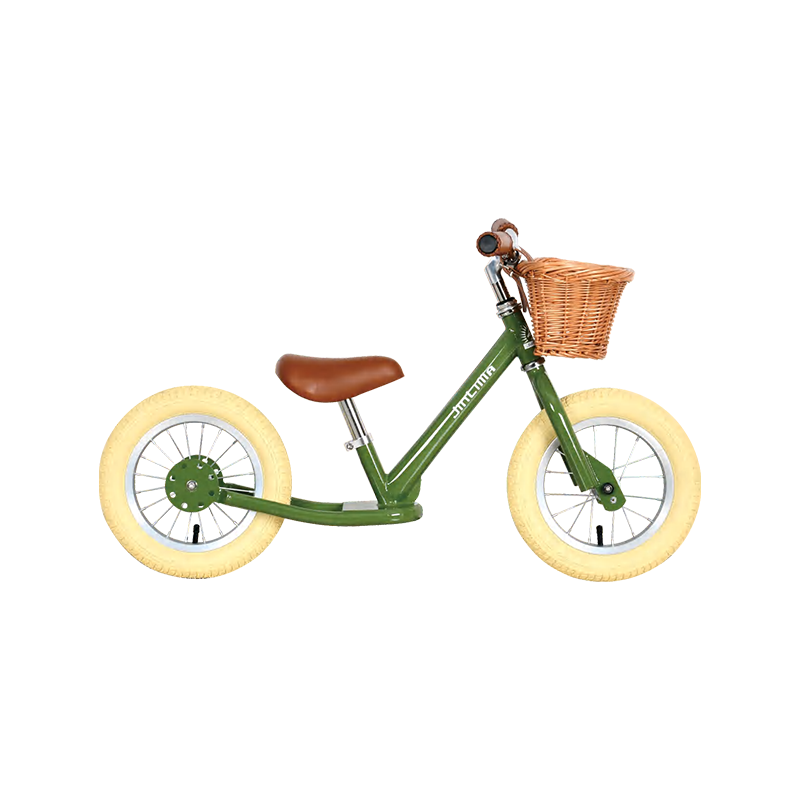The geometry of a toddler bike plays a crucial role in ensuring stability, comfort, and ease of use for young children, especially during the early developmental stages when they are learning how to balance and ride. The key elements of toddler bike geometry that influence these factors include the frame design, handlebar positioning, seat height, wheel size, and wheelbase. Here's how each aspect of geometry contributes to the bike's performance and the child's experience:
1. Low Center of Gravity
Importance: A low center of gravity helps ensure that the bike is stable, reducing the likelihood of tipping over while the child is riding. When the child is seated lower to the ground, they can put their feet down more easily, which improves their ability to balance and regain control if needed.
Impact: Bikes with a low center of gravity tend to be more stable, making them easier for toddlers to handle. It also provides the child with more confidence when learning to balance and maneuver the bike.
2. Short Wheelbase
Importance: The wheelbase is the distance between the front and rear wheels. A shorter wheelbase increases maneuverability and responsiveness, which is ideal for young riders who need to make quick, small adjustments to their balance while learning to ride.
Impact: A short wheelbase allows for tighter turns, making it easier for toddlers to navigate around obstacles and adjust their trajectory. This is especially important in the early stages when children are still mastering control.
3. Seat Height and Position
Importance: The seat height should be adjustable so that toddlers can comfortably sit with their feet flat on the ground, allowing them to push off easily and stop the bike by standing. The position of the seat also influences the child’s posture and ability to control the bike.
Impact: A lower seat height helps toddlers maintain control of the bike and quickly stabilize themselves if they begin to fall. Ensuring the seat is in a position that allows for a slight bend in the child's knees while riding provides comfort and ease of use.
4. Handlebar Height and Reach
Importance: The handlebars should be positioned in such a way that the child can easily reach them without overstretching, while still maintaining an upright posture. The handlebar height impacts the child’s balance and comfort when riding.
Impact: Handlebars that are too high or too low can cause discomfort or difficulty in controlling the bike. Proper handlebar geometry encourages a relaxed arm position, helping toddlers to steer the bike more easily and with less fatigue.
5. Steering Angle and Head Tube
Importance: The steering angle (or rake) of the front fork affects how responsive the bike is to the child’s steering inputs. A steeper steering angle can make the bike turn more quickly, while a shallower angle provides more stability but less responsiveness.
Impact: For toddler bikes, a moderate steering angle is ideal. It provides the right balance of stability and responsiveness, helping toddlers to make turns without feeling like the bike is overly twitchy or difficult to steer.

6. Wheel Size
Importance: The size of the wheels impacts the bike's stability and ease of handling. Smaller wheels are lighter and offer more agility, while larger wheels can roll over rougher terrain more easily.
Impact: For toddler bikes, smaller wheels (typically 12” to 14”) are preferred. These wheels are easier for young riders to control, accelerate, and stop. They also make the bike lighter and more manageable, which is important for toddlers who are still developing their strength and coordination.
7. Fork and Frame Design
Importance: The fork design (i.e., the shape and angle of the front fork) affects how smoothly the bike rides. A well-designed frame will absorb shocks and provide a stable platform for the child to learn to balance on.
Impact: Rigid forks (non-suspension) are typically preferred for toddler bikes because they provide more stability on smooth surfaces and are easier to maintain. The frame design should be lightweight and compact, making the bike easy for the child to maneuver.
8. Pedal and Crank Position (for Pedaled Bikes)
Importance: The position of the pedals and cranks affects the child’s ability to pedal efficiently and comfortably. For toddlers who are transitioning from balance bikes to pedal bikes, the geometry should allow them to reach the pedals easily while maintaining a proper leg angle for pedaling.
Impact: Pedals should be positioned so that the child’s feet can reach them comfortably while seated. Too high or too low of a pedal position can make pedaling awkward, potentially causing frustration or difficulty in learning to ride.
9. Frame Clearance
Importance: Adequate frame clearance (the space between the seat and the frame, and between the bottom bracket and the ground) is essential to prevent the bike from becoming too restrictive for the child’s movement.
Impact: Good frame clearance allows toddlers to easily straddle the bike and get on and off without risk of injury, and ensures that they can move their legs freely when pedaling or scooting.
10. Handlebar Grips and Padding
Importance: The shape and material of the handlebars and grips should be ergonomically designed to accommodate small hands, ensuring comfort and control.
Impact: Soft, padded grips can help prevent hand fatigue, and handlebars with appropriate width and angle allow for better maneuverability. Proper handlebar geometry ensures that toddlers can grip them comfortably without losing control.


 0
0











 Linhang industry park, Zhuji,
Linhang industry park, Zhuji,  +86-18858280688
+86-18858280688
